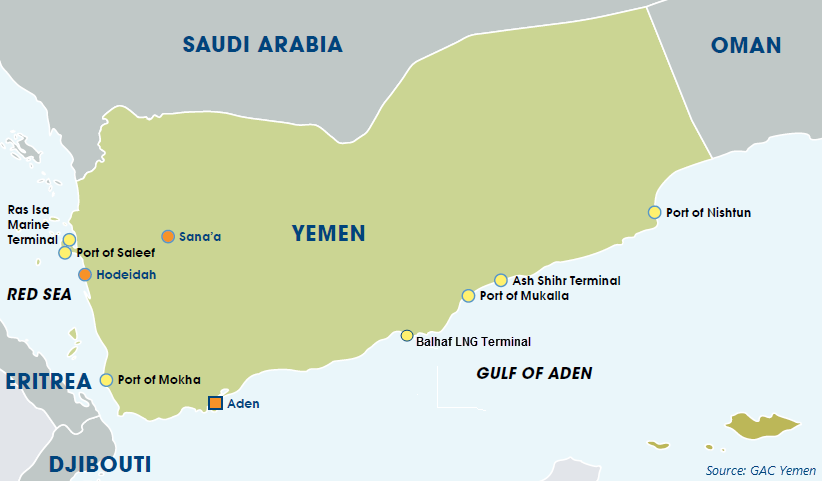Yemen, a sovereign nation situated in the Arabian Peninsula with its official capital in Sana’a, boasts a strategic location for maritime trade. Surrounded by the Gulf of Aden to the South and the Red Sea to the West, Yemen has historically served as a crucial hub in global shipping routes. Its proximity to the Guardafui channel, near the Horn of Africa, further enhances its significance in international trade. Sharing borders with Saudi Arabia to the North and Oman to the East, Yemen also lays claim to numerous islands surrounding the Guardafui Channel.
Despite enduring political turbulence impacting its shipping industry, Yemen remains a pivotal point for global logistics operations. Companies like Maersk maintain a presence in Yemen, facilitating the movement of goods worldwide. While challenges persist, including mandatory naval checks for ships approaching Yemen and piracy issues prevalent in the region, maritime activities persevere.

Top 10 major ports in Yemen supporting trade and commerce:
Port of Aden (Main Port)
Located east of the Red Sea and Bab El Mandeb, the Port of Aden benefits from a natural harbor within a crater, making it one of the world’s few natural harbors. Boasting a 13-kilometer waterfront and nearly 6 kilometers inland, the port serves as a crucial gateway for shipments destined for Yemen and neighboring regions like Saudi Arabia. Notably, Aden offers night navigation services and repair facilities, distinguishing it as the largest natural deep-water port in the area.
Aden Container Terminal (ACT)
Specializing in container vessel traffic, ACT features two Panamax class berths capable of accommodating ships up to 350 meters in length. Equipped with four gantry cranes and a container yard with a 10,000 TEU capacity, the terminal facilitates efficient cargo handling operations.
Aden Refineries Terminal
Complementing the main port, the Refineries Terminal handles transshipment of crude oil, petroleum, and refined products. With facilities such as Atmospheric Distillation Unit and LPG Unit, it plays a crucial role in processing various cargo types.
Port of Al Hodeidah
A major seaport on the Red Sea, Al Hodeidah specializes in exporting commodities like coffee, cotton, and dates. Operating eight berths capable of handling diverse cargo types, including humanitarian aid shipments, the port serves as a vital lifeline for Yemen.
Port of Saleef
Situated near Al Hodeidah, the Port of Saleef primarily handles container vessels and bulk cargo carriers. While facing challenges such as poor rail and road connectivity, Saleef remains significant for its salt exports and grain handling facilities.
Port of Al Makha
Known for its coffee exports, the Port of Al Makha serves as a crucial maritime node despite reduced traffic compared to neighboring ports. Operating a single pier, Al Makha requires onboard equipment for cargo handling due to limited facilities.
Ras Isa Oil Terminal
Renowned for its oil operations, Ras Isa Terminal facilitates large-scale oil shipments on the Red Sea coastline. With a permissible sea depth of 35 meters, it accommodates supertankers and plays a pivotal role in Yemen’s oil industry.
Ash Shihr Port and Oil Terminal
Located in the Hadhramaut Governorate, Ash Shihr Terminal specializes in exporting commodities like incense, fish, and oil. Supported by offshore terminals and SPM systems, it serves as a key export point for Yemen’s oil industry.
Wharf of Ma’alla
Operated as a multipurpose terminal, Ma’alla Wharf handles diverse cargo types, including grain and flour shipments. Featuring berths for bulk and container vessels, Ma’alla contributes significantly to Aden’s maritime activities.
Port of Mukalla
While one of Yemen’s smaller seaports, Mukalla Port offers a dry dock for repair and maintenance operations. Despite its size, Mukalla plays a crucial role in handling overflow cargo from larger ports and supports imports to the region.


Latest Products
Onwa KR-1068 Marine Radar
AED 16,850.0Original price was: AED 16,850.0.AED 14,643.0Current price is: AED 14,643.0.Onwa KP-27F 7-inch GPS Chart Plotter with 600W Fish Finder
AED 2,850.0Original price was: AED 2,850.0.AED 1,740.0Current price is: AED 1,740.0.Onwa KEC-70G / KA-GC9A Electronic GPS Compass
AED 2,065.0Original price was: AED 2,065.0.AED 1,565.0Current price is: AED 1,565.0.Onwa KEC-70G / KA-SC90 Electronic GPS Compass
AED 11,500.0Original price was: AED 11,500.0.AED 9,250.0Current price is: AED 9,250.0.